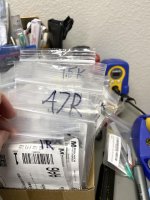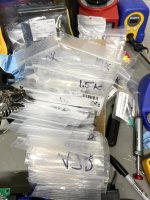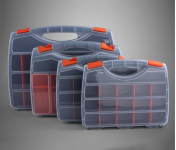I finally broke down and decided to put all my resistors in one place and in order. Between 12 or 20 different projects it was getting very hard to find what I needed, searching between all those boxes. My five year old son even helped label a bunch. 😀
Attachments
Sure, that works. I do the same thing except I use what they call coin envelopes. The brown manila envelopes maybe size of 3x5 card. I stack them like you did, and I write the value, wattage, and whatever else I care about on the flap. On the body of the envelope I might log the source I used and part number there and any special notes like these were the special resistor used in a MOOG model or whatever. Your Mouser stickers probably have the same information.
I also do this for like diodes and small transistors, and in those cases I might include the part number at Peavey or Yamaha or Fender or whoever, if that is appropriate.
Good to get the kid involved. "Son, go fetch me a couple 220k, please."
I also do this for like diodes and small transistors, and in those cases I might include the part number at Peavey or Yamaha or Fender or whoever, if that is appropriate.
Good to get the kid involved. "Son, go fetch me a couple 220k, please."
You can search AliExpress, eBay or maybe even Amazon for something like "empty SMD sample book".
For parts that are sensitive to ESD you could use these: mSleeve – EEVblog
For parts that are sensitive to ESD you could use these: mSleeve – EEVblog
Thanks for the additional tips Enzo and Kn0ppers. Yes, I kept the original Mouser bags because they have a lot of useful info on them. I typically make a part number with the name of the project those parts are for so I can reference later as well.
I re-use the Mouser and Digikey bags myself. When I write the information on the bag with a Sharpie, I have learned to write on the inside of the bag so it doesn't wear off.
There are zip-loc bags available with matt white stripes for permanent marker / biro use. For instance: https://www.transpack.co.uk/grip-seal-bags-write-on-panel-3-5x4-5I have learned to write on the inside of the bag so it doesn't wear off.
Don't use whiteboard pens, and the only permanent colour seems to be black of the "permanent" markers.
I like those divider bins for some things as well. find them in the fishing tackle area of the store, they are used for keeping lures, and weights, and hooks, whatever. But I also find similar bins in the sewing department. They are used for little bobbins of embroidery thread and what not.
I used to like the divider bin approach, and it's fine if you have a limited number of components. But if you're talking resistors or capacitors, you may have literally THOUSANDS of different values. The bins simply cannot accommodate that efficiently. The coin envelope method allow easy I.D. and will store many more values in the same physical space. I also find that, if you're careful, you can peel those Mouser plastic bag labels off and re-stick them on the coin envelopes, thus preserving all the info.
A set of five 40-drawer units (200 total drawers) does my E12 resistors, electrolytics, transistors and film caps. I have both SMT 0805 and through-hole resistors sharing a drawer which helps.
Separately I have some kits of RF inductors and caps, they come with own organizational packaging.
Other random SMT stuff tends to go in these handy units: 50 Pcs/Set SMD SMT Electronic Component Container Mini Storage Boxes kit | eBay
Separately I have some kits of RF inductors and caps, they come with own organizational packaging.
Other random SMT stuff tends to go in these handy units: 50 Pcs/Set SMD SMT Electronic Component Container Mini Storage Boxes kit | eBay
Bins and drawers are great for surface mount, not so great for leaded parts, especially if you will often have the need for full-length leads and cannot pre-trim them for storage.
Resistors and diodes go in my envelopes, which are large enough for full length leads. Tackle boxes are not great for resistors, but something like trim pots or a collection of generic 16mm pots. I used one for my collection of jack and pot nuts. Another for my collection of metric screws.
The drawers I use are 10 x 5.5 x 3.5cm, adequate for anything I can think of - I'm not subdividing them.Bins and drawers are great for surface mount, not so great for leaded parts, especially if you will often have the need for full-length leads and cannot pre-trim them for storage.
Many of them come with moveable dividers to accommodate different items. They also make some rather large ones. I find them very handy when I have to take parts with me.I used to like the divider bin approach, and it's fine if you have a limited number of components.
The best storage solution I've ever seen for SMD parts was a set of small cylindrical containers that screwed into each other's bases so that they formed tall stacks. When you wanted a specific part you just unscrewed the stack at that level.
Unfortunately I've never been able to find them for sale.
Unfortunately I've never been able to find them for sale.
> a set of small cylindrical containers that screwed into each other's bases so that they formed tall stacks
Bead containers.
FEAMOS 5 Layer Stackable Bead Containers Small Item Plastic Round Clear Storage Jar Box - Walmart
25pc 1.25 inch Plastic Storage Containers - Screw Together
Bead containers.
FEAMOS 5 Layer Stackable Bead Containers Small Item Plastic Round Clear Storage Jar Box - Walmart
25pc 1.25 inch Plastic Storage Containers - Screw Together
> a set of small cylindrical containers that screwed into each other's bases so that they formed tall stacks
Bead containers.
FEAMOS 5 Layer Stackable Bead Containers Small Item Plastic Round Clear Storage Jar Box - Walmart
25pc 1.25 inch Plastic Storage Containers - Screw Together
Holy cow! Thank you PRR, I've been looking for those for years. Hope they're on Ebay, no Walmart here.
Edit: Yay! They're available from China, pretty cheap too. Sometimes you just need to know what the darned things are called.
Last edited:
- Home
- Design & Build
- Parts
- Getting Organized!


